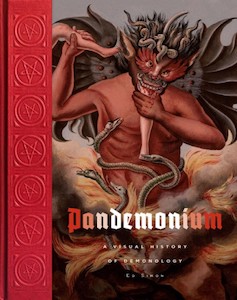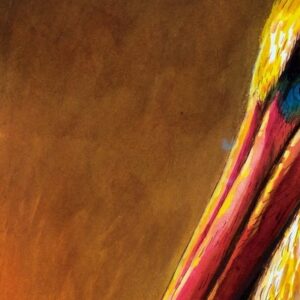When I reveal that I wrote a book about demonology, I’m invariably asked if I believe that demons are actually real. “Of course, I don’t think that demons are actually real,” is the expected response and the one that I give. “I’m a modern, secular, educated, liberal, agnostic man. I don’t believe in demons and devils, goblins and ghouls, imps, vampires, werewolves, ghosts, or poltergeists either.” Yet whenever giving the doxology of all of that which we’re not to have faith in, I’m mentally keeping my fingers crossed, because so much of that question depends on the definitions of the words “believe,” “demons,” “actually,” and “real.”
Since the Enlightenment, Western intelligentsia have been the inheritors to a rather anemic model of knowledge known as the correspondence theory of truth, whereby the validity of a statement is ascertained simply by whether or not it matches empirical reality. If I say, “The dog is in the yard,” that statement is either true or false depending on whether or not said dog is in said yard. Easy enough, but then what of statements like “A thing of beauty is a joy forever,” “I think that I shall never see/a poem as lovely as a tree,” or “I wondered lonely as a cloud?”
A fundamentalist adherence to the correspondence theory of truth, trumpeted by logical positivists and other philosophical heretics, would consign John Keats, Joyce Kilmer, and William Wordsworth into a bin marked “meaningless” (even though I think we can all ascertain that there is meaning, even if it’s the “slant” truth that Emily Dickinson writes about). And so, you can imagine what is made of statements about divinity and diabology (though theology has, in my estimation, always just been a branch of poetics anyhow).
That the correspondence theory of truth doesn’t even match its own exacting prescriptions to what is legitimate or not is a bit of self-referential absurdity best passed over; concluding that as a model it’s clearly ineffectual in describing whole swaths of human experience is sufficient enough. You can see my difficulty with the question of whether or not I “actually” believe in demons—I reject the entire epistemological attitude in which the query is posed. If the question is asked in the spirit of ascertaining whether or not demons exist as tangibly as a dog in the yard, then obviously the answer is in the negative, and yet in those moments of sublime terror when approaching the core of the cracked numinous, I can’t help but know what I felt. That warped smile and those red eyes might not be staring back at me from the yard, but they’re staring back from somewhere.
Of the approaches that the modern person has in considering demonology, there’s obviously blunt literalism, equally blunt denialism, and then a sort of vast middle that reduces demons to “metaphors” or “symbols.” Concerning those who think of demons as being as “real” as the dog in the yard, little can be said. Such fundamentalism is its own capitulation to the exigencies of modernity; it’s as positivist as anyone adhering to the correspondence theory of the truth, it merely chooses to ascent toward that which anyone can see is an absurdity. Those who adhere to this contention may think that they’re taking part in a venerable spiritual tradition, but they hold to the same epistemological framework as any rationalist or skeptic, they just choose to believe in something demonstrably wrong.
Denialists are a different species, to harp on the nonexistence of demons is to miss the point in the same way as the literalists but toward a different direction. Smugly emphasizing that demons aren’t real seems about the same as arguing that “Truth is beauty, beauty is truth” is an absurdity because it can’t be reduced to symbolic logic; those who expel poetry in favor of the syllogism live a shallow existence. Most obnoxious of this type are those who reject anything that to them has the taint of the spiritual, the divine, the transcendent about it, consigning millennia of human experience and expression into the trash can because it doesn’t conform to a model of truth that has only existed for a few dozen generations.
You can see my difficulty with the question of whether or not I “actually” believe in demons—I reject the entire epistemological attitude in which the query is posed.
Most appealing is perhaps those who maintain that demons are potent and powerful explanatory symbols, that they are deeply significant metaphors. Such a position has the benefit of being partially true, of course. Demons are powerful metaphors. In Lucifer we have a symbol of unbridled pride, in Azazel the intermixing of good and evil, in Moloch the horrors of rapacious consumption. And of course, from a literal perspective, one need not believe that there is a batwinged entity in the bowels of the earth, or that goat- and bull-headed deities stalk our nighttime.
Yet there is something finally unsatisfying in reducing the demonic to the mere metaphorical. I do not say that with any self-satisfaction, for metaphor is the grand medium of language, the atoms of our thoughts and emotions, wherein no true human expression can take place without that blessed word “like.” When considering the demonic, however, the metaphorical model offers what’s ultimately an incomplete understanding of something that is realer than real, which exists in a dark poetry that is uttered beyond the realm of mere words. Demonic names are performative, they’re incantatory, they’re ritualistic, and even though they don’t correspond to “actual” things in the “real” world, they very much gesture toward that aforementioned dark something.
Between the correspondence theory of truth and the metaphorical theory of truth, I propose a third option—that our demonology conforms to some type of reality, but an ineffable one, a hidden one, an inexpressible one that can neither be measured nor understood but that is somehow closer to us than the atoms of our very breath. In such a schema it is held that the postulates of demonology are always poetic, that they are not to be verified or disproven, and that the signifier and signified of the word “demon” is forever deferred. Holding that words like “demonic” or “satanic” are metaphorical terms for evil, that they carry within them all the overloaded cultural connotations that they imply, is an obvious truism—but they’re more than metaphors as well. What is the reality to which they refer, endlessly contingent and always shifting, filtered through centuries and a multitude of cultures and faiths? I have no idea, having never seen behind the veil.
That is the nature of the numinous; it’s forever beyond my simple comprehension, or of anyone else’s perceptions as well, for that matter. In Pandemonium, there is an emphasis on the importance of demonic names—Azazel, Mephistopheles, Lucifer, Baphomet, Moloch, and so on—because being able to a give proper name to something is crucial to controlling it, an inviolate principle of demonology. Don’t mistake my personal argument as being that these names refer to things in quite the same way that the word “car” simply corresponds to that which is parked in front of my house. The truths that they convey are something far more elemental, charged, and indefinable.
The German Lutheran theologian Paul Tillich wrote in his 1951 Systematic Theology that “God does not exist. He is being itself beyond essence and existence. Therefore, to argue that God exists is to deny him.” Insomuch as the demonic is within the realm of the sacred, where that word connotes not goodness so much as those things that are other from our profane reality, I think that paradoxically something like this is true for demons as well.
What I offer is a theory of demonology as filtered through something that I call “demonic poetics.” As a neologism, it is meant to refer to the parsing of how humans have interacted with this numinous reality, this demonic something, throughout history. “Poetics” because there is an understanding that literary language is relative, allegorical, symbolic, metaphorical, and that it gestures toward the transcendent; “demonic” for obvious reasons. When presenting a history of demonology, what is necessarily being explicated is humanity’s understanding of the subject rather than the reality itself, for the simple reason that the latter is impossible to approach rationally. “The truth is difficult to get at; it is dynamic rather than statis; and it exists in the tension between the knower and that which is known,” writes Jeffrey Burton Russell in Mephistopheles: The Devil in the Modern World. “We cannot ever grasp ultimate truth, but we can point toward that truth by engaging ourselves, by thinking clearly, and by not muddling categories.”
Chief among the categorical mistakes people make is to assume that a scientific truth is the same across all domains of experience, an error that is the heresy of positivism. That’s not to reject science at all—far from it, for as Russell makes clear, the empirical method is the “most impressive and dramatic system in human experience,” but that has led some to erroneously assume it’s the only system, and to thus reject truths that in poetry and faith would be nonsensical in science (and it is within the former that demons live).
Russell, whose knowledge and reasoning have indelibly marked Pandemonium, sought a phenomenological approach to understanding absolute evil, wherein the subject of the satanic and the demonic can’t be approached the same way that we discuss a chemical reaction or genetic sequencing, but rather by examining the experience of people as they’ve been impacted by that ineffable something hidden beyond the sensory realm. His attitude is such that though it is “true that the Devil cannot exist in a scientific sense . . . he can [still] exist in a theological sense, in a mythological sense, in a psychological sense, and in a historical sense; and these approaches are, like science, capable of fixing a course on truth.”
What’s clear, obviously, is that many people in the past did literally believe in demons, and that they were as tangible and visceral as a hammer and a chair. But because the largest swath of human history also coincided with the experience of a charged and enchanted reality, there was also always the perspective that demons (and all other sacred things) had an elevated, transcendent, realer-than-real constitution to them as well. Because ours is an era rendered anemic by the tyranny of positivism, where disenchantment reduces everything to the ontological status of a hammer or a chair, we’ve tended to disbelieve in things that can’t be measured and weighed. Russell and I agree that that is a philosophical mistake. I see no reason why my not believing in imps scampering through the darkness of my basement means that I must reject the existence of demons crawling through the blackness of my soul. To that end, I would pose several principles that motivate this work:
The Principles of Demonic Poetics
1. Whether demons exist or not, peoples’ experience of them absolutely exists.
2. The demonic is a network of metaphors, symbols, and images that define the diabolical; they shift and interact with each other in different ways across the centuries.
3. As symbols, demons can mean variable and often contradictory things.
4. There is no clear distinction between categories of the aesthetic and the occult, and demonic poetics is an interpretive frame that understands the literary and the magical as fundamentally the same thing.
5. Some demons are always more symbolically ascendant in a given epoch.
6. Demons exist at the crux of the transcendent, the numinous, the sublime; they are by definition evil, but they are also by definition an aspect of the sacred. There is a something at the core of being that encompasses both the divine and the diabolical, but our language to describe it is always contingent.
7. A history of demonology is by necessity a history of the world.
Pandemonium is largely an exegesis of these principles, though they in large part emerged through the actual writing of the book itself. As a set of axioms, or arguments, or theses, they are not necessarily self-evident, which is of course part of the reason why I have systematized them. There is a sense in which Pandemonium’s chapters have been organized according to this schema, such as in analyzing a given demon who is representative of an era’s zeitgeist, the focus on close readings of literary works, and the emphasis on the variability of individual demons’ symbolic import, as with Lucifer’s evolution from being the embodiment of evil and rebellion to being understood as a Romantic hero. It’s taken as a motivating given that there is this intangible something, an ineffable sacred for which language is inadequate, so that our discourse must always be constructed (though no less significant for it).
True to its subtitle, Pandemonium is more a history of demonology than it is of individual demons. Certainly, all that you would expect is there in terms of demonic hierarchies, ancient grimoires with their incantations, and the conjurers who garnered a reputation for working in the occult arts. There is ample consideration given to otherworldly entities with names like Ba’al and Mammon, but more than an encyclopedic listing of such creatures (for there are other volumes which do that) the book is the first comprehensive popular history of demonology as a discipline of study. That means that the focus is on how people—from Cornelius Agrippa to John Dee, Aleister Crowley to Anton LeVey—have imagined the demonic, and the resultant work that they produced in that regard.
I see no reason why my not believing in imps scampering through the darkness of my basement means that I must reject the existence of demons crawling through the blackness of my soul.
Furthermore, Pandemonium doesn’t limit itself to figures normally categorized as occultists, as I also provide an analysis of how the demonic influenced the work of ostensibly mainstream philosophers like René Descartes, Friedrich Nietzsche, and Hannah Arendt (among others). The hermetic tradition, so often marginalized by mainstream academe, has exerted a greater influence than has been supposed, and the glittering sheen of the demonic can be espied within the cannon far more than is given credit.
Though I’m (technically) an academic, Pandemonium is not a traditional scholarly volume, though it is an interpretive and a critical one, and I’ve certainly relied on the invaluable research of historians, theologians, philosophers, and literary theorists. I make no claims to the book being a comprehensive study, though it is wide-ranging. Undoubtedly Pandemonium reflects my biases, interests, blind spots, and prejudices, so for that I beg a certain indulgence and understanding from my readers. More important than any individual analyses, any particular close reading, any recounting of a particular figure, event, or text, what’s most crucial is the basic argument of Pandemonium—that because Satan is the prince of this world, any history of demonology is de facto also a history of the world.
Demonic poetics is always an expression of the ineffable, where our words are ever variable, so that demons provide invaluable imaginative metaphors for each epoch to uniquely understand itself in relation to not just evil, but reality more generally. In the details there is certainly much to quibble about, but to the detriment of my academic career, I’ve always held that it’s more important to be interesting than completely correct, and while I hope that I’m both, the bulk of desire is that I’m at least the first.
A final personal anecdote, though perhaps it’s more of a parable, if slightly askew. More than a decade ago, when I briefly lived in that grubby industrial metropolis of Glasgow, I used to sometimes take the train to Edinburgh to spend the day. While both cities shared a certain Scottish melancholy, Edinburgh was the far more gothically atmospheric, a town of narrow, crooked cobblestone streets lurching up the side of a steep mountain, a cloistered medieval place that wore its history as thick as the dark clouds that would move across the Midlothian lowlands. True to its general demeanor, Edinburgh had a number of ghost-haunting tours that you see in any city with a history that’s long, bloody, or preferably both. These are the sorts of sojourns through moody seaside dock districts and drafty old manors where hard-up drama students wear period costume and speak in affected old-fashioned diction. Not being particularly better than anyone else who chooses to part with a few quid in that endeavor, I ventured to take part in Edinburgh’s manifestation of that venerable and corny tradition.
The particular tour that I went on were through the South Bridge Vaults, a honeycombed network of subterranean rooms accessible from street level through a number of heavily padlocked doors, which in the eighteenth century housed a massive destitute population displaced by the Georgian revitalization of the area across the valley from Edinburgh’s original Old Town. Within this chthonic realm of the forgotten there was a community of the impoverished and the criminal, an entire hidden kingdom underneath the footsteps of respectable Edinburgh crossing the South Bridge.
Taverns, distilleries, slums, and brothels all lined the vaults; it’s long been legend that the notorious serial killers William Burke and William Hare, who supplied fresh corpses to the anatomy students at Edinburgh University, would commence their hunt within the district. This was an area for rogues, libertines, rakes, and swindlers, an unhappy and cursed place. Bricked up and forgotten for two centuries, the vaults had been rediscovered accidentally by a Scottish rugby star in the 1980s, and quite predictably they became a star feature for the city’s fanny-pack-wearing tourists.
When I toured in a damp and cold Scotland of 2007, the Edinburgh Vaults delivered on their promise of providing an appropriately unnerving experience. All were composed of tightly packed, crumbling tan bricks, which give each one of the subterranean vaults the appearance of a large oven. An enthused guide led us through the network of claustrophobic rooms, our path illuminated by electric lights in iron cages meant to look as if they were lit by gas. We were entertained by our chaperon (again, predictably, a drama student) with a combination of historical accounts, grotesque stories, and naturally, reports of supernatural occurrences. One room, identically to all the rest, had been the site of a massive conflagration in the eighteenth century whereby a hundred people were literally baked to death, leaving the city authorities unable to tell where one person’s body part ended and another’s began, the whole bevy of humans reduced to a burnt, quivering mass of flesh. In another, we were told of how Burke and Hare would kidnap women and men, stab them, bundle them up, and then deliver them to the medical school where they’d be carved apart for educational purposes. And then, finally, there was the most terrifying room of all.
Demonology is built with the stones which capture that force within, each pebble a name that humans have chosen to try and make sense of something which is fundamentally senseless.
Otherwise nondescript, and supposedly of no historical import, this particular vault had been chosen as the site for a neo-pagan group’s worship services. Altars and chairs had been set up, and the members would gather once a week like any other religious community, but they encountered a problem. Every single week they’d discover that though the vault was locked, all of their ritual objects were scattered about, the chairs knocked over, the pages ripped out of their books.
Finally, the leader of this particular community, a druid who had some knowledge of the ancient hauntings that bedeviled this land, volunteered to spend the night to see what force, whether human or spectral, took to vandalizing their grove. Our guide, with theatrical flourish, reported that in the morning, the shaking druid, a man familiar with the exigencies of the supernatural, refused to give detail on what he’d witnessed during the night, but he demanded that his group’s place of worship be moved out of that vault immediately.
As a final offering, he assembled a number of rocks and arranged them in a circle with a diameter about the height of a strapping man, performing a ritual to forever imprison that which had been haunting the vault into the cairn. Whatever had happened to the druid that night, whatever he’d experienced, he took great care to make sure that this powerful force, this absolute evil, would be constrained by this magic, incapacitated lest somebody should disrupt its prison.
Our guide was good. She made a showy routine out of the circle, emphasizing that though she was too cautious to ever step across its boundaries herself, Great Britain was a free country, and certainly any one of the people on the tour would be welcome to enter into the supposed spirit’s domain if that was their decision. On our tour was a young man who couldn’t have been much more than nineteen or twenty, who embraced the aesthetic of the vaguely disreputable British chav subculture. Think oversize Burberry jacket, backward ball cap, gold chains, and expensive tennis shoes. He was with two pretty women, and perhaps in an effort to seem fearless, he jumped into the center of the cairn, aped a few obscene gestures, loudly laughed, and gave his audience a profane closing V-sign.
After his performance, the group continued on its way, but something seemed wrong with the young gentleman. Where once he was loud, now he was quiet; where before he was vulgar, now he seemed cowed; where once he was a braggadocio, now he was a frightened boy. After around half an hour had passed, our fearless explorer into whatever abyss was in that circle started to cry, breaking down in front of the women whom he had once clearly hoped to take home, and he was all but nonverbal when asked by the guide what was wrong. The group had to stop as an ambulance was called, and a security guard arrived to take the young man up to street level.
Now, I’ve no idea what happened there. Perhaps, despite all the initial swagger, he was the psychosomatic sort, impressionable and easily made anxious. Or, maybe he was an actor employed by the tour group to give a bit of eerie verisimilitude to the proceedings. Finally, maybe he met whatever exists within that infinite kingdom of the impossible; perhaps he went deep within that abyss and came out the other side changed, different. If the demonic is a something that exists at the core of the invisible, a land beyond words or description, language or normal vision, then demonology has always provided a safer means in approaching that realm. Demonology is built with the stones which capture that force within, each pebble a name that humans have chosen to try and make sense of something which is fundamentally senseless. All of you now reading are standing on the outer side of those rocks, looking into the pure negation that is contained by that cairn. Take it as prudent advice that it’s best never to cross that threshold. Are demons real? I’m not going to step into that circle. Would you?
_______________________________________________________

Excerpt from the new book PANDEMONIUM: An Illustrated History of Demonology by Ed Simon published by Cernunnos. Text copyright © 2022 Ed Simon.
Ed Simon
Ed Simon is the Public Humanities Special Faculty in the English Department of Carnegie Mellon University, a staff writer for Lit Hub, and the editor of Belt Magazine. His most recent book is Devil's Contract: The History of the Faustian Bargain, the first comprehensive, popular account of that subject.













